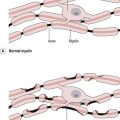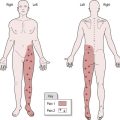Motor neuron disease
Definition
Motor neuron disease (MND) is a group of progressive neurodegenerative diseases that attack the upper and lower motor neurons (S2.13). Although four distinct types of MND are described, there is a great deal of overlap between them.
Amyotrophic lateral sclerosis (ALS)
This is the most common form of MND affecting both upper and lower motor neurons.
Aetiology
Familial MND
Other genes
TDP-43 (TAR DNA binding protein): there is evidence to suggest that the TDP-43 protein might be involved in most cases of MND, even when the gene for its manufacture is not mutated. TDP-43 is known to be a regulatory protein and when mutated, abnormal proteins are manufactured causing the cell to malfunction. For some reason, the cell then becomes labelled for destruction.
Sporadic MND
Mechanical trauma: An individual, who experiences a serious head injury or more than one head injury, has a slightly higher risk of ALS
Diet: A diet lacking in polyunsaturated fat and vitamin E has been linked with individuals who have developed MND. Researchers believe that the two elements normally have a combined effect in protecting motor neurons from MND
Electrical trauma: There is some evidence that occupational exposure to extremely low magnetic fields may be linked to MND
Toxins: There is some evidence linking agricultural chemicals/heavy metals and smoking with MND
High levels of exercise: Recent research has found a link with MND and professional football players. However, other factors such as mechanical trauma, exposure to toxic chemicals used on football fields and the cocktail of performance-enhancing and sports injury-related drugs may also be contributory.
Pathology
Outcome and prognosis
Amyotrophic lateral sclerosis: Average life expectancy is from 2–5 years from onset of symptoms
Progressive muscular atrophy: Most individuals live for 5–10 years
Primary lateral sclerosis: Life span could essentially be normal
Progressive bulbar palsy: This form is aggressive and relentless, with life expectancy being between 6 months and 3 years from onset of symptoms.
Signs and symptoms
The signs and symptoms presented will be a combination of:
Motor
Progressive bulbar palsy (PBP)
• Dysarthria (cranial nerves VII, IX and XII) (S3.16): Slurring of speech. Nasality and loss of volume in speech are frequently the first symptoms
• Dysphagia (cranial nerves IX and XII) (S3.16): Difficulty swallowing. This may lead to an inability to protect the airway when eating/drinking and the risk of aspiration into the lungs.
Secondary complications
• Cognitive: Although historically patients with MND were not considered to present with cognitive dysfunction, recent evidence has shown approximately 20% of those diagnosed with ALS do have deficits of higher executive function (S3.33) and personality
• Respiratory insufficiency: Common in patients with bulbar dysfunction, and at late stages with respiratory muscle weakness
• Psychosocial (S3.16): Depression, anxiety, lack of confidence, change of role, financial
• Change in postural alignment (S3.20)
References and Further Reading
Campbell, WW. The cranial nerves. DeJong’s The neurologic examination. London: Lippincott Williams and Wilkins; 2005.
Gotkine, M, Argov, Z. Clinical differentiation between primary lateral sclerosis and upper motor neuron predominant amyotrophic lateral sclerosis. Archives of Neurology. 2007; 64:1545.
Hughes, TA, Wiles, CM. Neurogenic dysphagia: the role of the neurologist. Journal of Neurology, Neurosurgery and Psychiatry. 1998; 64:569–572.
Kadekawa, J. Clinicopathological study of a patient with familial amyotrophic lateral sclerosis associated with a two base pair deletion in the copper/zinc superoxide dismutase (SOD1) gene. Acta Neuropathologica. 1997; 94:617–622.
Lapiedra, RC, Moreno Lopez, LA, Esparza Gomez, GC. Progressive bulbar palsy: a case report diagnosed by lingual symptoms. Journal of Oral Pathology and Medicine. 2002; 31:277–279.
Nixon, H, Non neuronal cells. 17th International Symposium on ALS/MND. Motor Neuron Disease Association, 2006. www.mndassociation.org/research
Strong, M, New clues on how TDP43 causes motor neurons to die. 19th International Symposium on ALS/MND. Motor Neuron Disease Association, 2008. www.mndassociation.org/research
Swash, M, Desai, J. Motor neuron disease: classification and nomenclature. ALS and Other Motor Neuron Disorders. 2000; 1:105–112.
Tartaglia, MC, Rowe, A, Findlater, K, et al. Differentiation between primary lateral sclerosis and amyotrophic lateral sclerosis: examination of symptoms and signs at disease onset and during follow-up. Archives of Neurology. 2007; 64:232–236.





